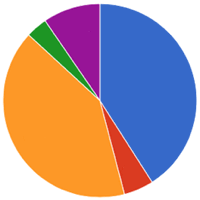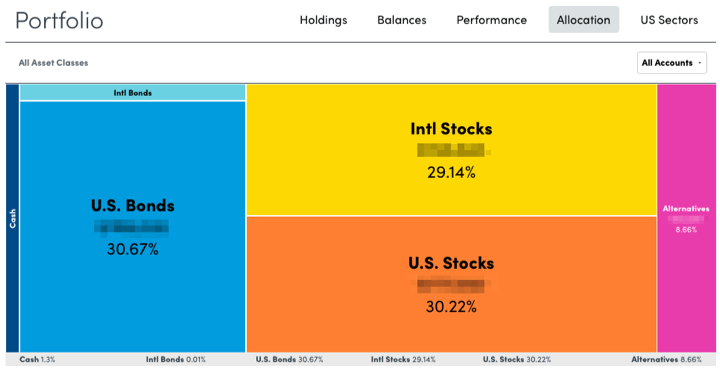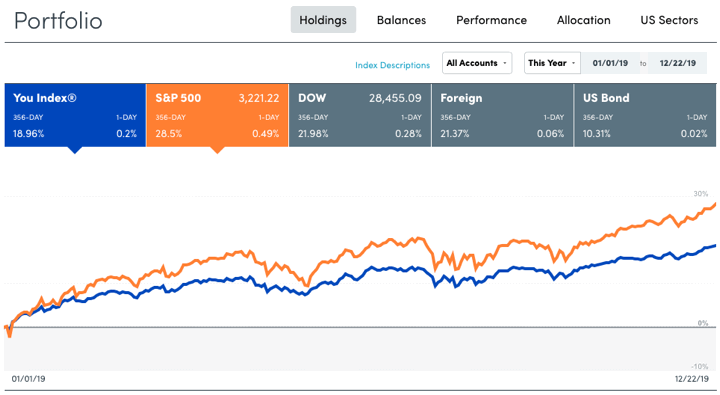
Plenty of people will tell you what you should own, but I’d rather they just share what they actually own. Here’s my year-end portfolio update for Q4 2019, including all of our 401k/403b/IRAs, taxable brokerage accounts, and savings bonds but excluding our house, cash reserves, and a few side investments. Dividends tend to arrive on a quarterly basis, and this helps determine where to invest new cash to rebalance back towards our target asset allocation.
Actual Asset Allocation and Holdings
I use both Personal Capital and a custom Google Spreadsheet to track my investment holdings. The Personal Capital financial tracking app (free, my review) automatically logs into my accounts, adds up my balances, tracks my performance, and calculates my asset allocation. I still use my manual Google Spreadsheet (free, instructions) because it helps me calculate how much I need in each asset class to rebalance back towards my target asset allocation.
Here are my YTD performance and current asset allocation visually, per the “Allocation” and “Holdings” tabs of my Personal Capital account, respectively:


Stock Holdings
Vanguard Total Stock Market (VTI, VTSAX)
Vanguard Total International Stock Market (VXUS, VTIAX)
WisdomTree SmallCap Dividend (DES)
Vanguard Small Value (VBR)
Vanguard Emerging Markets (VWO)
Vanguard REIT Index (VNQ, VGSLX)
Bond Holdings
Vanguard Limited-Term Tax-Exempt (VMLTX, VMLUX)
Vanguard Intermediate-Term Tax-Exempt (VWITX, VWIUX)
Vanguard Intermediate-Term Treasury (VFITX, VFIUX)
Vanguard Inflation-Protected Securities (VIPSX, VAIPX)
Fidelity Inflation-Protected Bond Index (FIPDX)
iShares Barclays TIPS Bond (TIP)
Individual TIPS securities
U.S. Savings Bonds (Series I)
Target Asset Allocation. I do not spend a lot of time backtesting various model portfolios, as I don’t think picking through the details of the past will necessarily create superior future returns. I mainly make sure that I own asset classes that will provide long-term returns above inflation, distribute income via dividends and interest, and finally offer some historical tendencies to balance each other out. I make a small bet that US Small Value and Emerging Markets will have higher future long-term returns (along with some higher volatility) than the more large and broad indexes, although I could be wrong.
While you could argue for various other asset classes, I believe that it is important to imagine an asset class doing poorly for a long time, with bad news constantly surrounding it, and only hold the ones where you still think you can maintain faith through those fearful times. I simply don’t have strong faith in the long-term results of commodities, gold, or bitcoin.
Stocks Breakdown
- 38% US Total Market
- 7% US Small-Cap Value
- 38% International Total Market
- 7% Emerging Markets
- 10% US Real Estate (REIT)
Bonds Breakdown
- 33% US Treasury Bonds, intermediate
- 33% High-Quality Municipal Bonds (taxable)
- 33% US Treasury Inflation-Protected Bonds (tax-deferred)
I have settled into a long-term target ratio of 67% stocks and 33% bonds (2:1 ratio) within our investment strategy of buy, hold, and occasionally rebalance. I will use the dividends and interest to rebalance whenever possible in order to avoid taxable gains. I plan to only manually rebalance past that if the stock/bond ratio is still off by more than 5% (i.e. less than 62% stocks, greater than 72% stocks). With a self-managed, simple portfolio of low-cost funds, we minimize management fees, commissions, and taxes.
Holdings commentary. I know that US stock valuations are on the higher side, but this year of all-time US highs is another reminder that you still need to stay in the game. My forward expectations for US stock returns are muted, but I’m not selling a single share. International stocks have also hit an all-time high, but nobody really noticed because US stocks have still outperformed by a long shot this decade. I remain satisfied with my mix, knowing that I will own whatever successful businesses come out of the US, Europe, China, or wherever in the future.
On the bond side, my primary objective remains to hold high-quality bonds with a short-to-intermediate duration of under 5 years or so. This means US Treasuries, TIPS, or investment-grade municipal bonds. FDIC or NCUA-insured certificates would also fit in there. I don’t want to worry about my bonds. I then tweak the specific breakdown based on my tax-deferred space available, the tax-effective rates of muni bonds, and the real interest rates of TIPS. Right now, it is roughly 1/3rd Treasuries, 1/3 Muni bonds, and 1/3rd TIPS.
Performance numbers. According to Personal Capital, my portfolio went up +19% so far in 2019. I see that during the same period the S&P 500 has gone up +29%, Foreign Developed stocks up +21%, and the US Aggregate bond index was up about +10%.
An alternative benchmark for my portfolio is 50% Vanguard LifeStrategy Growth Fund and 50% Vanguard LifeStrategy Moderate Growth Fund – one is 60/40 and the other is 80/20 so it also works out to 70% stocks and 30% bonds. That benchmark would have a total return of +20.9% for 2019 YTD.
The goal of this portfolio is to create sustainable income that keeps up with inflation to cover our household expenses. I’ll share about more about the income aspect in a separate post.
 The Best Credit Card Bonus Offers – 2025
The Best Credit Card Bonus Offers – 2025 Big List of Free Stocks from Brokerage Apps
Big List of Free Stocks from Brokerage Apps Best Interest Rates on Cash - 2025
Best Interest Rates on Cash - 2025 Free Credit Scores x 3 + Free Credit Monitoring
Free Credit Scores x 3 + Free Credit Monitoring Best No Fee 0% APR Balance Transfer Offers
Best No Fee 0% APR Balance Transfer Offers Little-Known Cellular Data Plans That Can Save Big Money
Little-Known Cellular Data Plans That Can Save Big Money How To Haggle Your Cable or Direct TV Bill
How To Haggle Your Cable or Direct TV Bill Big List of Free Consumer Data Reports (Credit, Rent, Work)
Big List of Free Consumer Data Reports (Credit, Rent, Work)
Just curious…what’s your average total yield (not return) before taxes on a portfolio like this.
I haven’t run the numbers yet for this quarter but here are the numbers from last quarter (Q3 2019).
https://www.mymoneyblog.com/portfolio-income-september-2019-q3.html
Jonathan: Do you have a spreadsheet or template that makes it easy to balance across all of your accounts (e.g. Roth IRA, traditional and taxable)?
Yes, spreadsheet template details are in the original post.
Thanks for the explanation–it was nice seeing how someone else is doing things–you are right, showing rather than telling was a breath of fresh air!
Hey! Long time reader. I’m curious why you don’t hold total bond market index – is it simply that it is too risky for your purposes? And to that point I guess that’s why you’ve not been tempted by international bonds? It just seems that some of those super low risk bond funds can pay less than a CD – have you ever been tempted to have CDs instead? Thanks!
I’m not a huge fan of corporate bonds for a few reasons. I’d rather just have the highest safety and the lowest correlation to stocks. People love yield right now and I think it’s suspicious that so many more corporate bonds are rated “just barely investment grade” than rated “just barely NOT investment grade”. Why might that be? Well, the bond ratings system is pretty much the same as before the financial crisis. The bond issuers pay the ratings agencies.
Jonathan,
If you’re in your late 30’s shouldn’t you be 100% in common stocks?
I think that advice (which I don’t necessarily agree with anyway) is based on the assumption that if you’re in your late 30s, you are likely to be accumulating and far away from the withdrawal phase. But for someone who is withdrawing from their portfolio, volatility matters a lot more because you are dealing with sequence of return risk. Take too much money out during the dips, and you could permanently damage your portfolio balance.
Hi Jonathan
Love all you blog about.
Was curious about 8 percent ‘alternative’ category on personal capital.
Is that your reit holdings?
Thank you and happy holidays and new year
Yes, Personal Capital classifies REIT under Alternatives.
Portfolio construction is a personal matter and I find its often difficult to communicate much less convince others of the efficacy of something that works for you. But I have to say, as far as Corporates and
Preferreds and Multi-Asset ETFs verses Municipals, I have a lot more faith in a Corporate with a strong balance sheet and CEO then almost any politically tinged, legally dubious Municipal.
It starts at the top, there’s the US government which is $22 Trillion in debt on the first set of phony books a $100 Trillion in debt with contingent liabilities and who doesn’t even have an interest in ever paying that off. And then you have State and Local Governments with the same political party bias of corruption, incompetence and amnesia when the the time comes to honor their debts or raise taxes to do so.
@justjoeguy2 — Yes, 100% stocks in your 30s, at least 80% at age 50, and never below 60% ever. The logic varies if you have a large account and spend <4% every year, or if you have little saved and spend the whole account in 10 years. Rapid spenders should have more bonds. Many people don't have significant retirement savings at all.
@Jonathan Ping — While I love your site and have visited for years, this is indeed a conservative portfolio. Bonds are programmed to stay flat or even lose over the long term.
@Mark — If governments stop paying, all paper assets are doomed. Buy gold now.
I'm tilted toward international stocks over bonds (e.g., 25% large domestic, 25% mid/small domestic, 35% foreign/EM, 15% bonds/cash) in my tax protected retirement accounts. This is because foreign/EM valuations are relatively low and many stocks are yielding 3%+. Even with no growth, foreign generally matches or outperforms most bonds.
Furthermore, I keep higher percentages of stocks in my retirement accounts because they will be spent relatively far in the future. There's a lot of time to recover — to include 10 or 20 years after retirement. While I used to keep REITs in my retirement accounts, I don't do this any more. REITs and dividend stocks are often bid up too high by those seeking utopian growth + yield. So they function as bonds with added volatility. Only AFTER retirement might I rebalance into yield stocks or REITs.
Finally, I do like triple tax free municipal bond funds (also yielding 2.5% to 3.5%) in my pre-retirement medium term accounts. Given complete tax avoidance, 3% would be an impossible 5% return with CDs/savings. After retirement I expect to routinely transfer tax protected funds (401k, IRA, Roth) into munis to maximize returns before spending.
The federal government prints its own money, so I’d say theyre the one entity you do not need to worry about defaulting. Could they print too much money and cause inflation, certainly, but thats a risk you face with any bond including corporate.
Hello Jonathan, You present several DIY scenarios, but what about Target Funds? Are there any drawbacks of target funds? They are very tempting as they don’t need work.
I have recommended Vanguard Target Retirement and LifeStrategy funds to my own family members. I think they are a fine choice, you just lose a bit of control as Vanguard can tweak their inner asset allocation whenever they want. You also lose the ability to do asset location for each asset class for tax efficiency.
Thanks. Not sure what this means – “asset location for each asset class for tax efficiency”. Could you please suggest a reading that explains this?
If you buy each asset class separately, you can put the tax inefficient ones in IRAs/401ks/403bs and put the more tax-efficient ones in taxable accounts. This may not matter to those who save predominantly in 401ks and IRAs. For example, I put all my REITs in tax-deferred accounts as they are not tax-efficient (dividends taxed as ordinary income).
Do you have a suggested reading that explains this?
“asset location for each asset class for tax efficiency”
Jonathan I’ve trying to get an answer on Targeted Maturity Bond Funds. If you hold the fund until the maturity date how do you know how much of your principle you will receive back? Vanguard and Ishares are both suitably vague on this point. Given that you don’t know how much the fund paid for the bonds verses the bonds par value, it seems impossible to know what the final payout of principle will be.
I am not an expert on this either, but it does seem like it would be hard to know exactly how much principal you’d get back.
When bonds mature they pay out at par, unless there was some type of default. You receive back the NAV of the fund at maturity of all bonds. You will need to know if you bought at a premium or discount to NAV, but unless there is a default and all bonds pay back at par,,,then you receive the par value plus interest payments along the way (except for zero coupons). Additionally, the cash from matured bonds will be invested in short-term MMFs and continue to pay prevailing short-term interest rates until the last bond matures in the fund.
Vanguard has a decent write-up on these funds from a few years back:
https://personal.vanguard.com/pdf/ICRDMB.pdf
WSJ article from earlier this year:
https://www.wsj.com/articles/the-pros-and-cons-of-target-maturity-bond-funds-11549056384
I would not expect one of these funds to be buying a bunch of premium bonds (materially premium) or discount bonds (material discount) as you will be investing in a IG fund most likely (HY bonds don’t return appropriately for additional risk incurred to HTM). Call up Guggenheim Partners and ask for the manager of the fund or email the guy and ask for specifics – I can’t imagine the guy not answering you in detail… most likely having one of his analysts do so – email now and put an anlayst to work for new years day!!!!